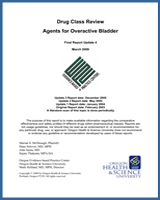NCBI Bookshelf. A service of the National Library of Medicine, National Institutes of Health.
This publication is provided for historical reference only and the information may be out of date.
Overactive bladder is defined by the International Continence Society as a syndrome of urinary frequency and urgency, with or without urge incontinence, appearing in the absence of local pathological factors. Treatment of overactive bladder syndrome first requires a clear diagnosis. In patients with incontinence, multiple forms can be present and it is important to determine which form is dominant. Non-pharmacologic, non-surgical treatment consists of behavioral training (prompted voiding, bladder training, pelvic muscle rehabilitation), transcutaneous electrical nerve stimulation, catheterization, and use of absorbent pads. Pharmacologic treatment for overactive bladder syndrome includes darifenacin, flavoxate hydrochloride, hyoscyamine, oxybutynin chloride, tolterodine tartrate, trospium chloride, scopolamine transdermal, and solifenacin succinate. The purpose of this systematic review is to compare the benefits and harms of drugs used to treat overactive bladder syndrome.
Contents
- Introduction
- Methods
- Results and Discussion
- Overview
- Summary
- Detailed Assessment
- Key Question 1. For adult patients with urinary urge incontinence/overactive bladder, do anticholinergic drugs differ in effectiveness?
- Key Question 2. For adult patients with urinary urge incontinence/overactive bladder, do anticholinergic incontinence drugs differ in safety or adverse events?
- Key Question 3. Are there subgroups of patients based on demographics (age, racial groups, gender), other medications, or comorbidities for which one anticholinergic incontinence drug is more effective or is associated with fewer adverse effects?
- References
- Appendix A. Glossary
- Appendix B. Search strategy
- Appendix C. Methods used to assess quality of studies
- Appendix D. Excluded trials
- Beta Adrenergic Blockers: Evidence Tables
Update 3 Report date: December 2005
Update 2 Report date: May
2005
Update 1 Report date: January 2004
Original Report date: February
2003
The medical literature relating to this topic is scanned periodically. (See http://www.ohsu.edu/ohsuedu/research/policycenter/DERP/about/methods.cfm for scanning process description). Prior versions of this report can be accessed at the DERP website.
The Drug Effectiveness Review Project, made up of 15 organizations including 14 state Medicaid agencies, commissioned and funded this report. These organizations selected the topic of the report and had input into its Key Questions. Content and conclusions of the report were determined entirely by researchers at the Evidence-based Practice Center. The authors of this report have no financial interest in any company that makes or distributes the products reviewed in the report.
Suggested citation:
McDonagh M, Selover D, Santa J, Thakurta S. Drug class review: Agents for overactive bladder. Update 4. http://www.ohsu.edu/drugeffectiveness/reports/final.cfm
The purpose of this report is to make available information regarding the comparative effectiveness and safety profiles of different drugs within pharmaceutical classes. Reports are not usage guidelines, nor should they be read as an endorsement of, or recommendation for, any particular drug, use, or approach. Oregon Health & Science University does not recommend or endorse any guideline or recommendation developed by users of these reports.
- Review Drug Class Review on Agents for Overactive Bladder: Final Report[ 2005]Review Drug Class Review on Agents for Overactive Bladder: Final ReportMcDonagh MS, Selover D, Santa J, Lopez S. 2005 Dec
- Treatments for overactive bladder: focus on pharmacotherapy.[J Obstet Gynaecol Can. 2012]Treatments for overactive bladder: focus on pharmacotherapy.Geoffrion R, UROGYNAECOLOGY COMMITTEE. J Obstet Gynaecol Can. 2012 Nov; 34(11):1092-1101.
- Agents for treatment of overactive bladder: a therapeutic class review.[Proc (Bayl Univ Med Cent). 2007]Agents for treatment of overactive bladder: a therapeutic class review.Hesch K. Proc (Bayl Univ Med Cent). 2007 Jul; 20(3):307-14.
- Responses of isolated normal human detrusor muscle to various spasmolytic drugs commonly used in the treatment of the overactive bladder.[Arzneimittelforschung. 2000]Responses of isolated normal human detrusor muscle to various spasmolytic drugs commonly used in the treatment of the overactive bladder.Uckert S, Stief CG, Odenthal KP, Truss MC, Lietz B, Jonas U. Arzneimittelforschung. 2000 May; 50(5):456-60.
- Review Trospium chloride for the treatment of overactive bladder with urge incontinence.[Clin Ther. 2005]Review Trospium chloride for the treatment of overactive bladder with urge incontinence.Singh-Franco D, Machado C, Tuteja S, Zapantis A. Clin Ther. 2005 May; 27(5):511-30.
- Drug Class Review: Agents for Overactive BladderDrug Class Review: Agents for Overactive Bladder
Your browsing activity is empty.
Activity recording is turned off.
See more...
